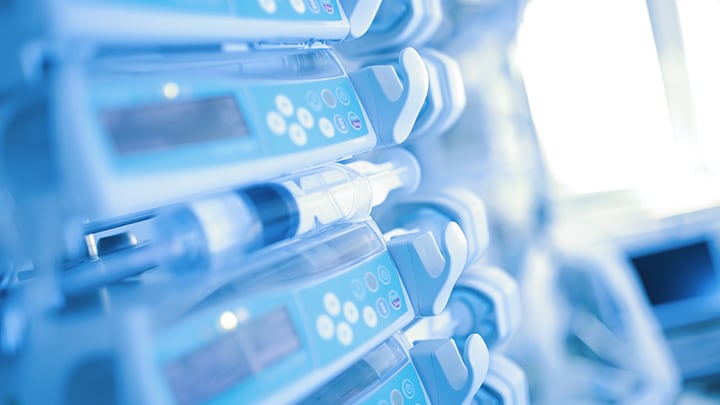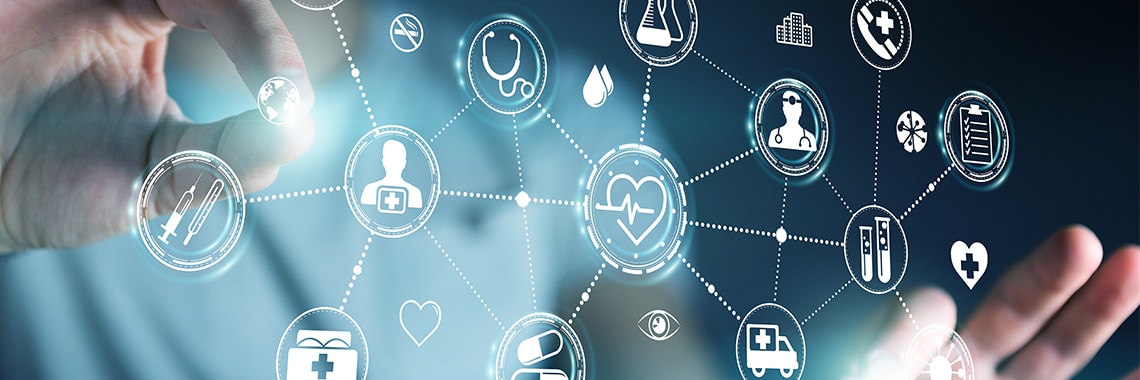To help improve collaboration and processes, enable more accurate access to real-time information, enhance decision-making and
even improve patient outcomes, a growing portion of the healthcare industry is using digital twins to collect, track and
analyze data about physical objects such as medical devices, pharmaceuticals and laboratory samples.
A Virtual Replica
A digital twin is an electronic representation of a real-world object, such as an infusion pump, a metered-dose inhaler or a
blood sample to be analyzed in a lab. The digital twin exists in virtual space and is mapped to its physical counterpart. Over
the lifetime of the physical object, changes in location, status and other key pieces of data are uploaded to the digital twin
for easy reference and sharing in real time.
A Rapidly Growing Trend
The ability to access and share up-to-date information about healthcare-related objects has tangible benefits for manufacturing,
the supply chain, medical facilities and patients.
In manufacturing and the supply chain, digital twins increase the efficiency of everyday operations, including automatic data
collection, track and trace, inventory updates, product authentication and analytics. At the same time, digital twins can also
share their information with other healthcare systems, to support important initiatives such as clinical trials and R&D.
Digital twins can also deliver benefits at the point of care, whether in a medical facility or the patient’s home, to help with tasks such as tracking dosages and monitoring expiration dates to ensure proper use and patient safety. Remote patient monitoring and
therapy adjustments can also be facilitated.
The return on investment for digital twins in the medical industry is so high, in fact, that twinning is an approach being
adopted throughout healthcare segments worldwide. According to the analysts at Markets and Markets, the global value of digital
twins, in terms of revenue, “is estimated to be USD $1.6 billion in 2023 and is poised to reach USD $21.1 billion by 2028,” for
a CAGR of 67%.
The Role of Wireless Connectivity
One reason why the healthcare industry is adopting digital twins is cost efficiency. The data associated with individual objects
can be reported to digital twins using widely available, cost-effective solutions for wireless connectivity, creating an
approach that offers both convenience and affordability.
Three wireless connectivity technologies in particular, RAIN RFID, high-frequency RFID (HF) and Near Field Communication (NFC)
are well suited for use with digital twins. These technologies use radio-frequency (RF) technology to record identities, events
and transactional data from physical objects.
Data with a unique identifier for an individual object is stored in a tag, which is a small electronic device, equipped with a
microchip and an antenna, that can transmit and receive data. Tags are compliant with worldwide standards and can support a
variety of functions, security levels and memory sizes. Recent advancements, for example, include authentication tags that
protect a tag’s source and data integrity and sensor tags that detect environmental changes and events, such as fill level or
evidence of tampering.
Passive tags don’t need a battery (they draw power from the reader) and can be applied with a label or embedded into the
product itself. When made part of the product, via plastic molding, for example, the tag is protected from adverse environmental
impacts and handling.
Wireless RFID-NFC edge technologies can improve supply chain control, process efficiency and patient product safety. Learn how in the upcoming webinar with our partner Identiv and
register now.
Each tagged item has a unique identity and can collect, store and report data at any point in the supply chain, from
manufacturing to the point of use and disposal. Tag readers send tag information to an on-premises or cloud-based network, where
data can be analyzed, shared, and stored.
 RFID-based unit-level traceability at manufacturing and beyond
RFID-based unit-level traceability at manufacturing and beyond
RFID or NFC?
When deploying digital twins, the choice of wireless connectivity – RAIN RFID, HF RFID or NFC – depends on the use case.
Distance and the number of items to be read are key factors.
Long-Range, Bulk Reads: RAIN RFID
RAIN RFID, which is a familiar part of automated warehousing and inventory tasks in a broad range of industries, operates in
the UHF band between 860 and 960 MHz. Dedicated RAIN RFID readers can accurately identify up to 1,000 items per second, at a
distance of up to 10 meters or more, and without line of sight, making it possible to do things like precisely identify all
the tagged boxes stacked on a pallet at once, or accurately register all the tagged individual items stored in a closed
container to an inventory list in one go.
Short-Range, Individual Reads: NFC
NFC, which is now a standard feature in nearly all smartphones worldwide, operates at 13.56 MHz and is used to identify
individual items at close range. Simply bringing an NFC reader or a smartphone to within a few centimeters of the tagged item
initiates an interaction with the item. The fact that NFC is readily available in most smartphones means that patients can
interact with items at the point of use, to access authentication, interactive support and more.
Mid-Range, Hybrid Solution: HF RFID
HF RFID, which operates at 13.56 MHz, supports vicinity-range applications of up to 1.5m with NFC functionality for data
exchange at close range. HF RFID is often used for smart cabinets and automated device-consumable communication.
Real-World Examples of Digital Twins in Healthcare
As mentioned above, RFID and NFC tags can be used to support digital twinning in a wide range of applications. Here’s a quick
look at some of the ways digital twins are being deployed in healthcare, from the point of manufacture to the point of use.
Manufacturing: Greater Process Efficiency and Control
RFID can automate work in process (WIP) tracking at the unit level. In pharmaceuticals, prefilled syringes (PFSs) can be
tracked individually at fill-finish line operations to mitigate mix-up risks and automate reconciliation. Enhanced
traceability, with the ability to read individual products within tubs, cartons and even pallets, for instantaneous
identification of units and sharing of cloud-based aggregation data, can be used across the full supply chain. In device
manufacturing, embedding a durable unit-level tag in the product automates tracking and enables automatic data collection
regarding the drawing or revision level of the build, as well as lot number and configuration data for constituent parts.
Supply Chain: Improved Transparency
Using enhanced track and trace features, manufacturers and distributors can scan, trace and update information about products
and, when combined with sensor IoT functions, can also manage environmental conditions, such as temperature control. Fully
aggregated setups add codes to the outside of containers and pallets, for more reliable parent-child relationships. Digital
twinning also supports blockchain initiatives, such as MediLedger, which trace products from production to quality control and
distribution.
Authenticity: Better Protection Against Counterfeits
Illegal trafficking, counterfeit drugs, sub-functional devices and substitute ingredients are, unfortunately, widespread
issues in healthcare. With a properly implemented system for digital twinning, manufacturers can ensure that only validated
medication is circulated, and only certified consumables are employed in devices. Identification validates serial numbers
online, authentication performs enhanced security checks based on a tag’s data, and credentials and authorization can confirm
rightful access to the device, its application and data. Special tamper-evident tags help safeguard contents by detecting
unauthorized product opening. Using NFC tags brings even patients into the process, with easy authentication of products
before purchase or use.
Clinical Trials: Stricter Compliance with Therapy Regimes
Clinical trials require significant time, money and resources, so it’s vital that studies of new medicines are carried out
efficiently and reliably. Digital twins, associated with things like NFC-enabled blister packs, which automatically capture
each pill removal with a day/time stamp when tapped with a smartphone, and NFC-equipped inhalers, which automatically record
each puff, support digital monitoring and can help ensure that patients involved in trials adhere to the prescribed dosage.
 Product safety and operational efficiency in hospitals
Product safety and operational efficiency in hospitals
Hospital Inventories: More Precise Traceability, More Timely Replacement
Proper tracking of materials, drugs and devices is essential, both in terms of operational efficiency and patient care. A
RAIN RFID reader, installed at the surgical storage area, can confirm the presence of instrument trays and packs, and verify
lot numbers and expiration dates, without compromising sterility. With this type of hands-free solution, manual stock counting
or barcode scanning by hospital staff is no longer necessary. Also, smart cabinets with built in HF readers, installed in
pharmacies or blood banks, can track items and quantities along with their batch numbers and expiration dates, and can
generate replenishments. NFC cards can authenticate staff members and authorize cabinet access while also documenting usage.
Device/Consumables Management: Safer, More Efficient Therapies
Devices with built-in NFC/HF readers can automatically ensure that inserted tagged consumables (e.g., reagents for analyzers)
are compatible with the device and procedure, check expiration data and self-configure for the right settings. In hospitals,
therapy adherence data can also be captured and uploaded to a database through a device with a network connection (e.g., an
infusion pump), complete with automated timestamps and batch number, to record what was administered when, and to whom.
NFC-enabled equipment can also report lot number and configuration data to technicians using handheld readers, for shorter
diagnostic and better maintenance cycles.
 Smart device and supplies management in hospitals
Smart device and supplies management in hospitals
In-Home Dosing Regimens: Greater Support, Better Adherence
Now that most people have an NFC-enabled smartphone, more patients are participating in self-monitoring and self-medication
programs. Simply tapping a smartphone to an NFC-enabled device or package of medicine, patients can quickly and easily access
product information, including step-by-step instructional videos, and can check things like product authenticity and proper
handling instructions or update a digital diary. Increasingly, integrated sensor-based feedback also confirms that devices
are handled properly or medication dosed correctly, further supporting patient care.
Digital Twins Provide True Digitization
Digital twinning, based on RAIN RFID, HF RFID and NFC, gives physical devices, medicines, consumables and equipment, a unique
digital identity, and then automatically and contactlessly captures, reads, controls and stores data locally on a device and
enables tracking in the cloud. The results are optimized operational processes, increased patient safety, improved clinical
outcomes and reliable product and supply-chain protection.
NXP Is an Innovation Leader
Building on our reputation for the delivery for high-quality, reliable solutions in healthcare, NXP holds leading positions in
every RFID and NFC segment, including tags and authentication, and readers for mobile phones and other contactless readers. We
also have an extensive partner network to provide local application and solution expertise globally.
Take the Next Step
Learn more about digital twinning and how NXP can simplify deployment with cost-effective NFC and RFID solutions.







